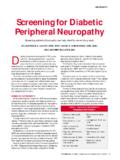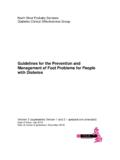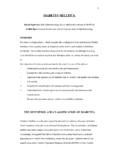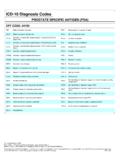Transcription of IWGDF Guidance on the prevention of foot ulcers in …
1 Authors S. A. Bus1; J. J. van Netten2; L. A. Lavery3; M. Monteiro-Soares4; A. Rasmussen5; Y. Jubiz6; P. E. Price7; on behalf of the International Working Group on the diabetic foot ( IWGDF )Institutions1 Department of Rehabilitation Medicine, Academic Medical Center, University of Amsterdam, Amsterdam, the Netherlands. 2 diabetic foot clinic, Department of Surgery, Ziekenhuisgroep Twente, Almelo and Hengelo, the Nether-lands. 3 Department of Plastic Surgery, University of Texas Southwestern Medical Center, Dallas, Texas, United States of America. 4 CIDES / CINTESIS Health Information and Decision Sciences Department (U753-FCT), Oporto Faculty of Medicine, Oporto, Steno Diabetes Center A/S, Gentofte, Denmark. 6 diabetic foot unit. Colombian Diabetes Association, Bogot , Colombia. 7 Vice Chancellors Office, Cardiff University, Wales, United Kingdom. Address of correspondence Sicco A. Bus, Academic Medical Center, Department of Rehabilitation Medicine, University of Amsterdam, Amsterdam, the Netherlands.
2 Phone: +31205666905, e-mail: by the IWGDF Working Group on prevention of foot UlcersIWGDF Guidance on the prevention of foot ulcers in at-risk patients with diabetes 2015 International Working Group on the diabetic FootThe2015challenge of theInternational Working GroupRECOMMENDATIONSPRACTICE-BASEDON THE diabetic FOOTon the diabetic FootThe2015challenge of theInternational Working GroupRECOMMENDATIONSPRACTICE-BASEDON THE diabetic FOOTon the diabetic FootRecommendationsIntroductionRecommend ations and RationaleKey controversiesReferencesIWGDF Guidance on the prevention of foot ulcers in at-risk patients with diabetes 2015 Systematic review The 2015 c hallenge of theInternational Working GroupRECOMMENDATIONSPRACTICE-BASEDON THE diabetic FOOTon the diabetic FootThe 2015 c hallenge of theInternational Working GroupRECOMMENDATIONSPRACTICE-BASEDON THE diabetic FOOTon the diabetic foot 2015 International Working Group on the diabetic FootPrepared by the IWGDF Working
3 Group on prevention of foot UlcersIWGDF Guidance on the prevention of foot ulcers in at-risk patients with diabetesRecommendations1. To identify a person with diabetes at risk for foot ulceration, examine the feet annually to seek evidence for signs or symptoms of peripheral neuropathy and peripheral artery disease. (GRADE recommendation: strong; Quality of evidence: low)2. In a person with diabetes who has peripheral neuropathy, screen for: a history of foot ulceration or lower-extremity amputation; peripheral artery disease; foot deformity; pre-ulcerative signs on the foot ; poor foot hygiene; and ill-fitting or inadequate footwear. (Strong; Low)3. Treat any pre-ulcerative sign on the foot of a patient with diabetes. This includes: removing callus; protecting blisters and draining when necessary; treating ingrown or thickened toe nails; treating haemorrhage when necessary; and prescribing antifungal treatment for fungal infections.
4 (Strong; Low)4. To protect their feet, instruct an at-risk patient with diabetes not to walk barefoot, in socks, or in thin-soled standard slippers, whether at home or when outside. (Strong; Low)5. Instruct an at-risk patient with diabetes to: daily inspect their feet and the inside of their shoes; daily wash their feet (with careful drying particularly between the toes); avoid using chemical agents or plasters to remove callus or corns; use emollients to lubricate dry skin; and cut toe nails straight across. (Weak; Low)6. Instruct an at-risk patient with diabetes to wear properly fitting footwear to prevent a first foot ulcer, either plantar or non-plantar, or a recurrent non-plantar foot ulcer. When a foot deformity or a pre-ulcerative sign is present, consider prescribing therapeutic shoes, custom-made insoles, or toe orthosis. (Strong; Low)7. To prevent a recurrent plantar foot ulcer in an at-risk patient with diabetes, prescribe therapeutic footwear that has a demonstrated plantar pressure relieving effect during walking ( 30% relief compared to plantar pressure in standard of care therapeutic footwear), and encourage the patient to wear this footwear.
5 (Strong; Moderate) RecommendationsIntroductionRecommendatio ns and RationaleKey controversiesReferencesSystematic review The 2015 c hallenge of theInternational Working GroupRECOMMENDATIONSPRACTICE-BASEDON THE diabetic FOOTon the diabetic FootThe 2015 c hallenge of theInternational Working GroupRECOMMENDATIONSPRACTICE-BASEDON THE diabetic FOOTon the diabetic foot 2015 International Working Group on the diabetic FootPrepared by the IWGDF Working Group on prevention of foot UlcersIWGDF Guidance on the prevention of foot ulcers in at-risk patients with diabetes8. To prevent a first foot ulcer in an at-risk patient with diabetes, provide education aimed at improving foot care knowledge and behaviour, as well as encouraging the patient to adhere to this foot care advice. (Weak; Low)9. To prevent a recurrent foot ulcer in an at-risk patient with diabetes, provide integrated foot care, which includes professional foot treatment, adequate footwear and education.
6 This should be repeated or re-evaluated once every one to three months as necessary. (Strong; Low)10. Instruct a high-risk patient with diabetes to monitor foot skin temperature at home to prevent a first or recurrent plantar foot ulcer. This aims at identifying the early signs of inflammation, followed by action taken by the patient and care provider to resolve the cause of inflammation. (Weak; Moderate)11. Consider digital flexor tenotomy to prevent a toe ulcer when conservative treatment fails in a high-risk patient with diabetes, hammertoes and either a pre-ulcerative sign or an ulcer on the toe. (Weak; Low)12. Consider Achilles tendon lengthening, joint arthroplasty, single or pan metatarsal head resection, or osteotomy to prevent a recurrent foot ulcer when conservative treatment fails in a high-risk patient with diabetes and a plantar foot ulcer. (Weak; Low)13. Do not use a nerve decompression procedure in an effort to prevent a foot ulcer in an at-risk patient with diabetes, in preference to accepted standards of good quality care.
7 (Weak; Low)RecommendationsIntroductionRecommend ations and RationaleKey controversiesReferencesIWGDF Guidance on the prevention of foot ulcers in at-risk patients with diabetesSystematic review The 2015 c hallenge of theInternational Working GroupRECOMMENDATIONSPRACTICE-BASEDON THE diabetic FOOTon the diabetic FootThe 2015 c hallenge of theInternational Working GroupRECOMMENDATIONSPRACTICE-BASEDON THE diabetic FOOTon the diabetic foot 2015 International Working Group on the diabetic FootPrepared by the IWGDF Working Group on prevention of foot UlcersIWGDF Guidance on the prevention of foot ulcers in at-risk patients with diabetesIntroductionFoot ulcers are a major complication of diabetes mellitus, with high morbidity, mortality, and costs (1-3). Yearly incidence is estimated to be around 2%, but this increases substantially when patients successfully heal from a foot ulcer, with reported recurrence rates between 30% and 40% in the first year (4,5).
8 prevention of these ulcers is of paramount importance to reduce the patient and economic factors & IWGDF definitionsNot all patients with diabetes are at-risk for ulceration. Key risk factors include presence of peripheral neuropathy, foot deformity, peripheral vascular disease, or a history of foot ulceration or amputation of (a part of) the foot or leg (1,6,7). In general, patients without any of these risk factors do not appear to be at-risk for ulceration. For the current Guidance , we define the at-risk patient in line with the definition from the International Working Group on the diabetic foot ( IWGDF ) as a patient with diabetes who does not have an active foot ulcer, but who has peripheral neuropathy, with or without the presence of foot deformity or peripheral artery disease, or a history of foot ulcer(s) or amputation of (a part of) the foot or leg (Box 1). Box 1: IWGDF definitions Peripheral neuropathy Loss of protective sensation foot deformity Peripheral artery disease Therapeutic footwear Note.
9 For all IWGDF definitions go to The presence of symptoms or signs of peripheral nerve dysfunction in people with diabetes, after exclusion of other causesInability to sense light pressure, as applied with a 10 gram Semmes-Weinstein monofilamentStructural abnormalities of the foot such as hammer toes, mallet toes, claw-toes, hallux valgus, prominent metatarsal heads, residuals of neuro-osteoarthropathy, amputations or other foot atherosclerotic vascular disease with clinical symptoms, signs or abnormalities on non-invasive vascular assesssment, resulting in disturbed or impaired circulation in one or more extremitiesSome form of customization to the patients foot regarding insole, shoe, and/or orthosisRecommendationsIntroductionRecom mendations and RationaleKey controversiesReferencesSystematic review The 2015 c hallenge of theInternational Working GroupRECOMMENDATIONSPRACTICE-BASEDON THE diabetic FOOTon the diabetic FootThe 2015 c hallenge of theInternational Working GroupRECOMMENDATIONSPRACTICE-BASEDON THE diabetic FOOTon the diabetic foot 2015 International Working Group on the diabetic FootPrepared by the IWGDF Working Group on prevention of foot UlcersIWGDF Guidance on the prevention of foot ulcers in at-risk patients with diabetesInterventionsIn most countries with developed healthcare systems, only patients at-risk for ulceration are entitled to reimbursement for preventative foot care.
10 Therefore, only interventions aimed specifically at the prevention of ulcers in at-risk patients are included in this Guidance . Within this group, those patients with a previous foot ulcer and/or amputation are considered at higher risk for ulceration when compared to those without (1,6). As such, first foot ulcer and recurrent foot ulcer are considered as separate outcomes of interventions for the prevention of foot ulcers are either used in clinical practice or have been studied in scientific research. These include interventions such as self-management, patient education, therapeutic footwear, or foot surgery, or the combination of two or more of these interventions into integrated foot this Guidance document, recommendations are given for each intervention separately, and include a rationale of how we came to each This rationale is based on a systematic review of the literature that underlies this Guidance (8), together with a consideration of benefits and harm, patients values and preferences, and costs related to the intervention.








